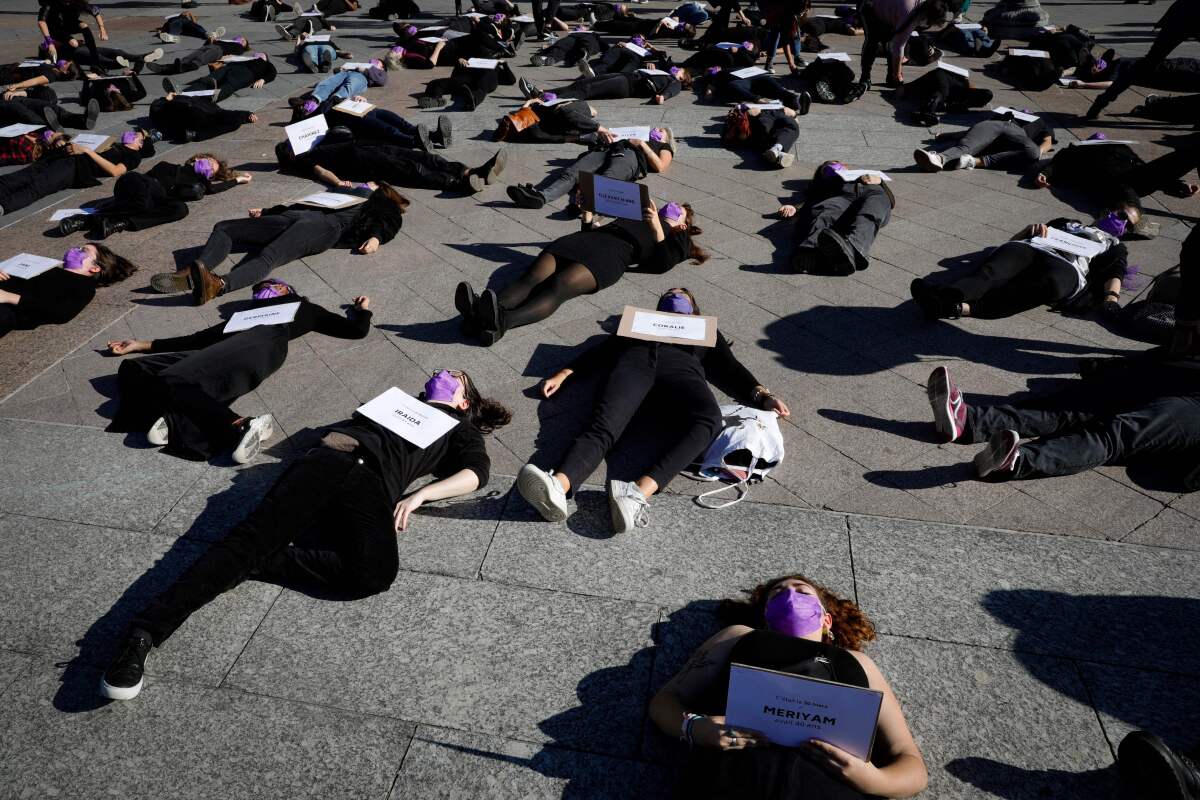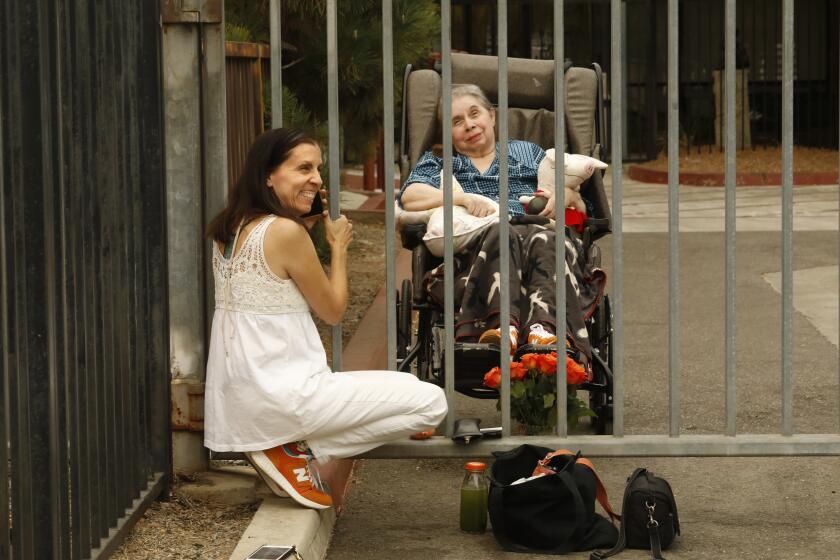A woman is killed by her partner or ex every three days in France. Activists want change

- Share via
PARIS — On the morning of Sept. 6, a 38-year-old mother of four left her apartment in the southeastern French town of Montélimar to go to work. Minutes later, her neighbors, hearing yells, emerged from their apartments to find her lifeless body in the hallway.
In that brief interval, the woman’s ex-husband had stabbed her about 30 times in the throat, neck, back and arms while her children, ages 4 to 15, watched, local media reports say. One had tried unsuccessfully to intervene. The former husband, who prosecutors allege was driven by extreme jealousy and rage, now awaits trial for murder.
The attack was shocking but, alas, not surprising. For all its reputation as a nation of romance, gallantry and love, France has one of the highest rates of conjugal killings in Western Europe.
So far this year, at least 94 women have been killed by a partner or former partner — a bleak tally that increases by one every three days on average, according to Femicide by Companion or Ex, an activist group that documents such slayings in France. The real number, the group says, is probably higher.

“We are certain that there are others,” said a woman who identified herself as Julia, one of four members of the organization, who work pseudonymously for security reasons.
Last year, 102 women in France died at the hands of their previous or current boyfriends or husbands, according to the French Interior Ministry. That was down from 146 in 2019, a drop that activists chalk up to the COVID-19 pandemic, because men who kill their partners often do so at the moment she tries to leave, and during lockdowns women had a much harder time leaving their homes.
A woman chronicles her mother’s awful journey, recounting her own pain and guilt as well as their reconciliation.
With people once again circulating freely, activists expect the number of victims in 2021 to approach the previous average of 130 per year.
President Emmanuel Macron’s government has repeatedly pledged to bring that figure down. In late 2019, it announced a raft of new measures to tackle the problem, including school programs to raise awareness of gender-based violence, the hiring of specially trained social workers in police stations, electronic bracelets to monitor abusers, increased capacity at domestic violence shelters and the confiscation of firearms from abusive spouses.
The $400-million package of new measures came on top of relatively robust laws against femicide, the term France uses for conjugal killing. But critics say those laws are unevenly enforced, thwarting any real improvement in the situation.
“France specializes in passing laws that they don’t apply, especially when it comes to women,” Julia said. “Apply the law. It’s very easy. Apply the law.”

The lack of progress came into grisly focus earlier this year with two high-profile slayings that forced the government to renew its promises to act more vigorously.
The first was May 4, when Chahinez Boutaa, a 31-year-old mother of three, was shot in the legs and burned alive by her husband in the middle of a street in broad daylight near the Bordeaux airport in southwest France. The husband had been convicted of domestic violence less than a year earlier and given an 18-month prison sentence, half of which was suspended.
He had repeatedly violated an order not to have contact with his wife. But she had not been given an emergency telephone, and he had not been fitted with an electronic monitoring bracelet — “great tools that too often remain in drawers” at police stations, Justice Minister Éric Dupond-Moretti lamented after the attack.
The second slaying occurred less than three weeks later when Stéphanie de Vincenzo, 22, was stabbed to death on a street in eastern France. She had filed multiple complaints with authorities after her partner threatened to kill her. He was fitted with an electronic bracelet but managed to take it off.
The incidence of injuries attributed to domestic partner violence rose sharply after the coronavirus outbreak began, and those injuries were more serious.
A government inquiry after Boutaa’s death found serious flaws in how authorities follow up with abusers. It also found a lack of coordination between police and the judiciary.
In response, officials pledged to prioritize domestic violence complaints and designate a point person in each police precinct. France’s domestic violence hotline, previously open only during weekday business hours, now offers round-the-clock service. Officials also announced the creation of a database that authorities can consult to assess an offender’s threat level, including information such as previous convictions and weapons possession.
But women’s advocates say such measures don’t address the root of the problem: a sexist, retrograde mindset that is deeply entrenched in French society. It’s even at work in the language, with, for example, the phrase “ma femme” meaning both “my wife” and “my woman.”
“Too many men think that their wife is their property,” said Hélène de Ponsay, vice president of the National Union of Femicide Families, a support group for families of victims of conjugal violence. “As long as men think that they can decide what their wife does, what she wears, who she sees, what she likes, where she works, whether she works or not, they will be their possession, and that needs to change.”
A dispute has broken out among French government officials over how to describe a wave of violent incidents this summer and how bad the situation is.
Such notions were enshrined in French law for more than a century, said Anne Bouillon, a lawyer who specializes in women’s rights and domestic violence. According to Article 324 of the Napoleonic Code of 1810, if a husband found his wife in their marital bed with another man, killing her was considered excusable.
“For decades, our legislation was discriminatory — men and women were not equal,” Bouillon said. “As long as the relationships are unequal, [where] one dominates the other, that carries the germ of violence.”
Article 324 was repealed in 1975, yet the argument of a “crime of passion” committed on the spur of the moment often still holds sway. Most femicides are no such thing, said Jane Monckton Smith, professor of public protection at the University of Gloucestershire in England and an expert in femicide.
“The research tells us that the vast majority of these homicides are planned, but they’re using the crime-of-passion narrative, and people understand it,” she said. “It has been around for so long. It is in the bone marrow of our Western culture and of cultures across the world.
Start your day right
Sign up for Essential California for the L.A. Times biggest news, features and recommendations in your inbox six days a week.
You may occasionally receive promotional content from the Los Angeles Times.
“These homicides are happening because women are trying to leave controlling men — they’re challenging their control,” she said. “That is how over 90% of these homicides happen, and yet we will still believe ... she did something to provoke him.”
By contrast, at a closely watched trial in central France earlier this year, 40-year-old Valerie Bacot was found guilty of murder for shooting her husband and burying his body after what she described as decades of abuse. Despite the conviction, the jury sentenced her to time already served after prosecutors said she posed no public threat and a petition in her support garnered more than 700,000 signatures.
Some of the abuse she suffered was psychological, the woman testified. Experts say it is important to understand that the exertion of coercive control is often a precursor to lethal violence.
“We need better training so that [the police] don’t consider bruises the only proof of abuse,” said De Ponsay, whose sister, Marie-Alice Dibon, was slain by her partner in April 2019 after 15 years of coercive control. “One of the reasons I got involved in this battle was because I really wanted people to understand that even if there is no bruise, you can be in great danger.”

Women are also sometimes unknowingly reporting domestic violence to male officers who are themselves abusers — a problem in many places, said Rachel Louise Snyder, an American expert on domestic violence and author of “No Visible Bruises.” “Rates of domestic violence in police departments are much higher than civilian rates,” she said.
Activists say awareness needs to be raised among those working in law enforcement and in the judicial system.
“A lot of it really does come down to education and training,” Snyder said. “A lot of good people do bad work because they don’t have the knowledge and training.”
The French government is working to change that. Earlier this year, Monckton Smith was invited to make a presentation to the French National Gendarmerie — “they were very receptive,” she said — and police, judges and social workers throughout France are increasingly receiving special instruction on how to deal with both victims and perpetrators of domestic violence and coercive control.
Bouillon said she sees a difference.
“It’s never enough, but it’s progressing,” she said. “People are working on it. ... It’s moving in the right direction.”
El-Faizy is a special correspondent.
More to Read
Sign up for Essential California
The most important California stories and recommendations in your inbox every morning.
You may occasionally receive promotional content from the Los Angeles Times.













